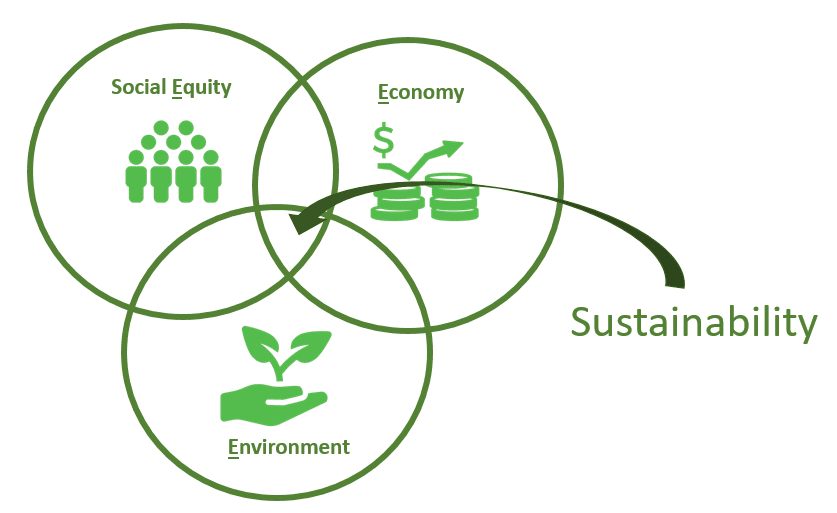Sustainability. The word is part of our everyday lexicon and front of mind in many board rooms, classrooms, and political offices around the world. Googling it returns more than 2 billion hits – that’s more than ‘Grand Canyon’ and ‘Major league baseball’ combined. But even with all this interest, there is much confusion about what sustainability really means. In fact, in that same Google search that returned over 2 billion hits, the most commonly searched questions are about what sustainability is and how to define it.
People search: Sustainability definition. What is sustainability and an example? What is a good example of sustainability?
“The Three E’s” is a framework designed to help define sustainability and provide useful guidance for how to apply the elusive concept of sustainability in day to day life.

What are the Three E’s of Sustainability?
The Three E’s of Sustainability refers to three pillars – environmental sustainability, economic sustainability and social equity. The framework asserts that in order for something to be truly sustainable, all of these pillars must be in perfect balance. For this reason, the Three E’s is often referred to as a three-legged stool, where every leg has equal importance and must be ‘sound.’ Let’s look at each of the three sustainability pillars in turn.
Pillar 1: Environmental Sustainability
Environmental sustainability is the most commonly discussed aspect of sustainability. Environmental sustainability encompasses all of the impacts that humans have on the natural world – from interacting with habitats and ecosystems, to extracting resources, to creating waste. These effects can be investigated on a local level (i.e. how does run-off in my neighborhood impact local waterways) or on a global level (i.e. how does human consumption contribute to global climate change).

Environmental Sustainability Is Not “Zero Impact”
One important aspect of environmental sustainability is that it does not require zero impact. Rather, it calls for ensuring that our eco-footprint doesn’t outpace the environment’s capacity to regenerate. So, for example, environmental sustainability does not call for an end to fishing or farming, but rather fishing in a way so that fish populations can renew and using farming practices that prevent soil degradation.
Pillar 2: Economic Sustainability
Economic sustainability can be considered in regard to communities, as well as businesses. A community that is economically sustainable is one where everyone in the community has the means to be economically supported, indefinitely. This of course requires sound infrastructure and effective use of community public services. A community that is economically sustainable has affordable housing for all, enough jobs, income stability, and support for small businesses.
The pillar of economic sustainability can be applied to businesses as well. A business that is economically sustainable is one where profit is not only being made currently, but will continue to be made in the future. An economically sustainable business is also resilient to unforeseen changes or disruptions (i.e. the business should not be dependent on artificially low energy costs).

Pillar 3: Social Equity
The third “E” calls for social equity. Too often, the benefits of sustainability are felt by too few, and there are those that get left behind due to race, income, age, gender, location, etc. In order to be truly sustainable, the benefits should be accessible to all, no matter what. At a community level, this means equal power and voice in decision making, and equal access to social and environmental resources. In the business world, fair wages, fair trade, an ethically sourced supply chain, and gender equality are all important factors. Compared to environmental and economic sustainability, the pillar of social equity is more of a newcomer in the definition of sustainability. And equity is generally considered harder to measure, since it relies on analysis of complex social systems rather than more clearly defined metrics of environmental impact or economic success.
Sustainability is a Balancing Act
As we continue to work toward sustainability both globally and in our day to day lives, the Three E’s framework can be a useful tool in both defining the word and upholding sustainable values. When assessing sustainability in our communities, our businesses, or our personal actions, it is important to consider all three pillars – not only environmental impacts, but economic and social aspects as well. Only when all three pillars are in balance, are we truly upholding the meaning of sustainability.
Image credits: Urban garden (Sustainably DC 33789 by Ted Eytan is licensed under CC BY-SA 2.0); Cafe passersby (Cafe by Paul Sableman is licensed under CC BY 2.0)




